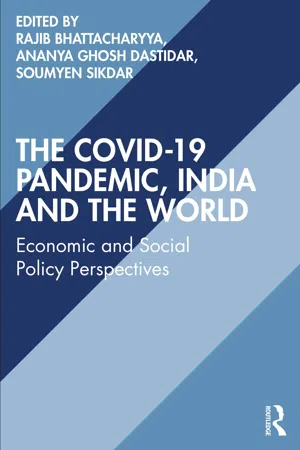Here we briefly discuss the impact of the pandemic on some major macroeconomic variables, viz., aggregate output, employment and international trade.
1.2.1 Economic growth
There will be a major setback to output growth as per estimates of major international organizations like the OECD, Asian Development Bank (ADB), UNCTAD and WEO. The disruption of global demand and supply chain coupled with the adverse impact on the financial markets translates into major contraction of economic growth and revisions in the global economic growth projections.
According to the OECD (March, 2020; June 2020), the world economy is expected to grow at 2.4% (instead of the initial estimate of 2.9%), while the growth of the European nations is expected to slow down from 1.2% to 0.8%. The adverse impact on confidence, financial markets and the travel sector and disruptions to supply chains all contribute to the downward revision of growth estimates in all G20 economies in 2020, especially those with strong links with China, such as Japan, Korea and Australia. According to the UNCTAD forecast (9th March, 2020), ‘Covid-19’ shock will trigger a recession in some countries and a deceleration of global annual growth to below 2.5%, often taken as the recessionary threshold for the world economy. Abiad et al. (2020), Dev and Sengupta (2020) have portrayed three different situations – best, moderate and worst case – depending on the intensity of future spread of the pandemic. Following the downward revision in consumption growth, reflecting a sharper than anticipated disruption activity, the WEO (World Economic Outlook, June 2020) has projected a global GDP growth of −4.9%. Weaker private consumptions, due to lockdowns and social distancing, coupled with rise in motives for precautionary savings along with subdued investment plans of firms are mainly responsible for this adverse shock to aggregate demand. According to Global Economic Prospects, June 2020, World Bank Group, the growth predictions are even gloomier. It estimates negative growth for the world economy (−5.2%) and across major economies around the globe, including the USA (−7%), Euro Area (−9.1%), Japan (6.1%) and India (−3.2%), to name only a few. Estimates in the Monthly Economic Review (August, 2020), Government of India, for the April–June quarter also point to significant global contraction of output on a year-on-year basis. In the case of India, RBI estimates (Table 1.1) indicate a sharp contraction in key macroeconomic variables like GDP, private final consumption expenditure (PFCE) and gross fixed capital formation (GFCF) in real terms in 2020–21; it is likely to be followed by some recovery in 2021–22 as restrictions are eased. Only agriculture and its allied activities are expected to register positive growth, while both industry and services are likely to shrink in 2020–21.
TABLE 1.1 India’s growth predictions in GDP, GVA and its components (%) | | 2020–21 | 2021–22 |
| 1. Real GDP growth rate | –7.6 | 9.5 |
| Real PFCE growth rate | –9.4 | 11.9 |
| Real GFCF growth rate | –14.5 | 12.1 |
| Real GVA growth rate | –7.3 | 9.3 |
| Agriculture and allied activities | 3.4 | 3.1 |
| Industry growth rate | –7.7 | 11 |
| Services growth rate | –9.6 | 10.1 |
| Gross saving rate | 29 | 28 |
| Gross capital formation rate | 26.9 | 28.1 |
Source: Authors’ calculations based on RBI – Survey of Professional Forecasters on Macroeconomic Indicators – 68th round (January 12–29 2021).
Indeed, India’s GDP contraction (23.9%) is the highest when compared with other nations such as the USA (9.1%), UK (21.7%), France (18.9%), Spain (22.1%), Italy (17.7%), Germany (11.3%) and Japan (9.9%). This severe contraction has been attributed to the most stringent lockdown measure implemented in India (as reflected by the Government Response Stringency Index, of the Oxford University, which assigned a value of 85.6, the highest in the world). It has been argued that the lockdown has enabled India to achieve the lowest fatality rate (1.78%, as on 31 August 2020) and has given an opportunity to restructure the health and testing infrastructure in the country. However, the move has also been widely criticized for its impact on livelihoods especially in the informal sector and on migrant workers. In this context, Debraj Ray, S. Subramanian and Lore Vandewalle discuss the contours of an alternate policy response in the chapter ‘India’s lockdown’, based on age-graded, rather than blanket restrictions on the working population. Despite the lockdown India has occupied the first spot for a continuous period of 50 days in terms of the highest daily infected from Covid-19 in the world. Currently, even as the surge in Covid cases continues, economic priorities have taken the centre stage, especially in emerging nations, and lockdown measures are being relaxed in gradual steps. The strategy suggested by Ray et al. is especially relevant at the current conjuncture. It would benefit the self-employed in the informal sector, who are most vulnerable as their meagre incomes and savings offer little scope for consumption smoothing in the face of such disruptive shocks. Another aspect of India’s lockdown relates to its impact on the population of migrant workers. Given hardly any time to plan, the total shutdown of economic activity left many of these workers stranded, without the means to sustain themselves in cities. The government’s response in the initial days of the lockdown reflected a lack of anticipation regarding their plight. As hordes of such workers took to the streets in desperation, a series of special trains were arranged for their journey back to rural hinterlands. Did the movement of migrants actually enhance the spread of Covid across India? This question is explored empirically in the chapter ‘Lockdowns, migrants and the spatial distribution of Covid-19 cases in India: consequences of a “tough and timely decision”’ by Zakir Hussain and Richa Kothari, on the basis of extensive spatial analysis on the movement of ‘shramik’ trains and spread of the disease. Given that Covid can happen again, the response, especially if it involves drastic mea...

